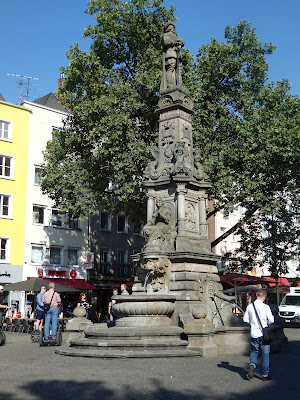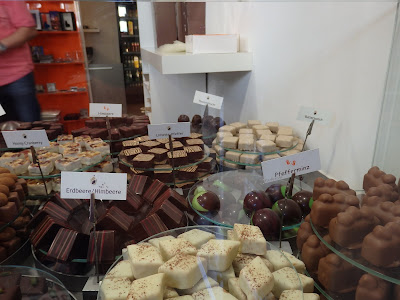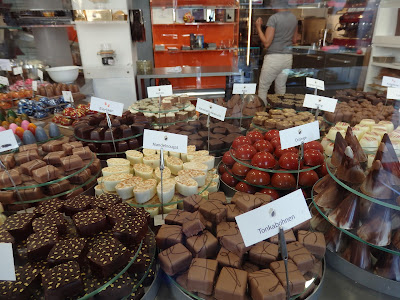 |
| We were already docked in Cologne when we woke up on September 12th. Saw these interesting buildings across the river. |
 |
| Looking out the back of the ship we could see Cologne Cathedral. I think the whiter church in front of it is Mt Martin Church. |
 |
| Mail delivery bicycle in Cologne |
 |
| Dedicated to St. Peter and the Blessed Virgin Mary, Cologne Cathedral was originally built to house the relics of the three Magi, which were given to the Archbishop of Cologne in 1164. |
 |
| This was in front of the church |
 |
| Roman north gate. |
 |
| Details from the front of the cathedral |
 |
| Full-scale model of finial. Now go back to the picture of the cathedral to see how small these look from the ground. |
 |
| Lots of different gargoyles |
 |
| Inside the Cathedral |
 |
| I sure wished the photos could have done justice to the windows. |
 |
| Notice how this window is cut in half? |
 |
| You can always click to enlarge the photo to see the details better. |
 |
| Some of the organ pipes. |
 |
| Side of cathedral |
 |
| We looked down into the area where workers created replacements for some of the stonework on the church. |
 |
| Well this angered the elves so they ran away and never returned to do any of the work again. |
 |
| The town hall in Cologne is famous for its loggia, the Renaissance façade. Erected between 1569 and 1573, it served to replace the run-down mediaeval entrance hall in front of the main hall. |
 |
| On the other side of the tower is the famous "Platzjabbeck", a wooden grotesque face sculpture which opens its mouth and sticks out its tongue when the tower clock strikes the hour. |
 |
| In the Old Market Square behind the tower (Alter Markt) is this medieval measuring device |
 |
In the center of the Alter Markt stands a fountain with a statue of Jan von Werth, a general in the Thirty Years War. The statue was erected in 1884.
|
 |
| Of course the fate of all statues is to be a roost for pigeons. |
 |
| Seems like it's good luck to touch the noses of the statues so you can see they are shinier than the rest of the figures. |
 |
| We went to this bar to sample the Kolsch. |
 |
| Kölsch is a clear, top-fermented beer brewed in Cologne. There is a strict definition of what is or isn't Kolsch. |
 |
| Next to the bar is a store much more to my liking. It's a chocolate store. Just amazing at all the pretty chocolates they make. |
 |
| I purchased a couple of the mint chocolates(green and brown). |
 |
| Back at the ship we had to descend the gangway to get to the upper skydeck. |





























No comments:
Post a Comment